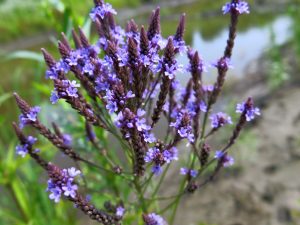
Scientific name: Verbena hastata is the North American species used, Verbana officinalis is the European species. Both are considered interchangeable in their properties.
Other names: Blue Vervain, American Blue Vervain, Vervain, Simpler’s Joy, Enchanter’s Plant, Herb of the Cross, Juno’s Tears, Pigeon’s Grass, Pigeon Weed, Herb of Grace
Family: Verbenaceae
Constituents
A significant number of active constituents of Blue Vervain have been identified, including: adenosine, aucubin, beta-carotene, caffeic-acid, citral, hastatoside, lupeol, ursolic-acid, verbenalin and verbenin.
Vervain is stated to possess sedative, thymoleptic, antispasmodic, mild diaphoretic and, reputedly, galactogogue properties.
Parts Used Medicinally
Root, leaves, stems.
The medicinal parts are the dried aerial parts collected during the flowering season, the fresh, flowering herb, the flowers and the whole fresh plant.
The older physicians used the root primarily, which they considered stronger. However, the primary parts used used medicinally by modern herbalists are the aerial parts of the plant.
Clinical Indications
- Nervous system support
- Mood improvement
- Anti-inflammatory
- Topical analgesia
- Promotion of estrogen and progesterone receptor binding
Traditional uses
Traditionally, Blue Vervain has been used for depression, over enthusiasm, melancholia, hysteria, generalised seizures, cholecystalgia, jaundice, early stages of fever, and specifically for depression and debility of convalescence after fevers, especially influenza. It is used for sore throat, and for diseases of the respiratory tract, such as coughs, asthma and whooping cough, menopausal complaints and irregular menstruation, gout, metabolic disorders, chlorosis and edema. It is also used externally as a gargle for cold symptoms and for diseases of the oral and pharyngeal cavity.
Chinese Medicine Uses: The herb is used for edema, chronic malaria, dysmenorrhea and carbuncles.
Homeopathic Uses: The herb is used for bruising and cerebral convulsions.
Dosage
Flowering herb: Standard Infusion, 2-5 ounces, to 3 times a day. Tincture [1:5, 60% alcohol] 30-90 drops, to 4 times a day. (Moore)
Liquid extract: Take 2 to 4 ml daily. (PDR)
Tincture: Take 5 to 10 ml up to 3 times per day. (PDR)
Infusion: Take 2 to 4 gm up to 3 times per day. (PDR)
Harvesting
Harvest the aerial parts in full flower. Blue Vervain is most potent when used fresh. Tinctures can be made from the fresh plant. It may be dried and stored in a cool, dark, place for use in teas but it will not have the potency of fresh Blue Vervain.
Contra-indications/Warnings
None documented.
Vervain should not be used during pregnancy.
Toxicity
Blue vervain appears to be safe if there are no concomitant conditions that warrant caution.
In vitro and animal study
A total aqueous extract of the aerial parts of Vervain hastata was found to have sedative properties in experiments involving male rats.
Chloroform, methanol and petroleum ether extracts of the aerial parts of vervain have anti-inflammatory activity in vivo as determined using the carrageenan-induced paw oedema model.
Source
Herbal Materia Medica by Michael Moore
Herbal Medicines Third Edition by Joanne Barnes, Linda A Anderson, J David Phillipson
PDR for Herbal Medicines by Joerg Gruenwald, PhD etal.
The information provided here are for educational purposes only, and is meant to help users better understand health concerns. This information should not be interpreted as specific medical advice. Users should consult with a qualified healthcare provider for specific questions regarding therapies, diagnosis and/or health conditions, prior to making therapeutic decisions.
DISCLAIMER: THIS WEBSITE DOES NOT PROVIDE MEDICAL ADVICE
The information, including but not limited to, text, graphics, images and other material contained on this website are for informational purposes only. The purpose of this website is to promote broad consumer understanding and knowledge of various health topics. It is not intended to be a substitute for professional medical advice, diagnosis or treatment. Always seek the advice of your physician or other qualified health care provider with any questions you may have regarding a medical condition or treatment and before undertaking a new health care regimen, and never disregard professional medical advice or delay in seeking it because of something you have read on this website.